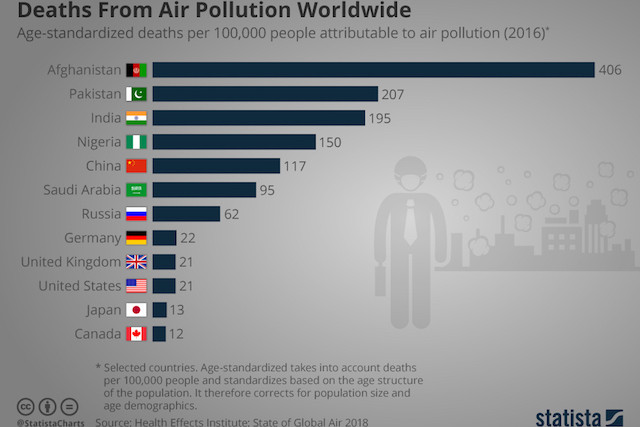Long-term exposure to air pollution contributed to just over 6 million deaths in 2016 with strokes, lung disease, lung cancer and heart attacks linked to many of them.
After smoking, high blood pressure and poor diet, air pollution is the fourth-highest cause of death worldwide with most deaths occurring in developing countries.
Even though India and China have the most deaths from air pollution worldwide with 1.61 and 1.58 million respectively, the statistics paint a different picture when it comes to age-standardized deaths per 100,000 inhabitants.
In 2016, Afghanistan had a far higher death rate per 100,000 inhabitants than India. In fact, polluted air is far more likely to harm Afghans today than insurgent attacks or air strikes. In Kabul, wood and plastic are burned in generators that belch out fumes. They then mix with emissions from lead-filled emissions from the city's snarling traffic jams. As bad as the situation is in the capital, things are also desperate in more rural areas where people burn solid fuels for cooking and heating in their homes.
That situation isn't unique to Afghanistan, however. Even though the stereotypical image of air pollution usually involves smoke stacks, smoggy skyscrapers and noisy traffic jams in megacities in India and China, much of it actually emanates from simple countryside stoves and generators. HEI’s report notes that over a third of the global population is exposed to household air pollution and that for them, fine particulate matter levels can exceed air quality guidelines by as much as 20 times.
This infographic shows that there is a striking gap between the most and least polluted air around the world. Developed countries have experienced success in reducing emissions and air pollution levels while poorer nations have fallen behind.
The situation isn’t totally grim with China in particular introducing tougher pollution controls in recent years. All of those people struggling with indoor air pollution are also experiencing a turn in fortune. Back in 1990, 3.5 billion people were exposed to it and that has now fallen to 2.4 billion despite an increase in the global population.
India has tried to eradicate indoor air pollution by providing people with LPG as a cooking fuel as well as expanding and modernizing its electricity grid.
